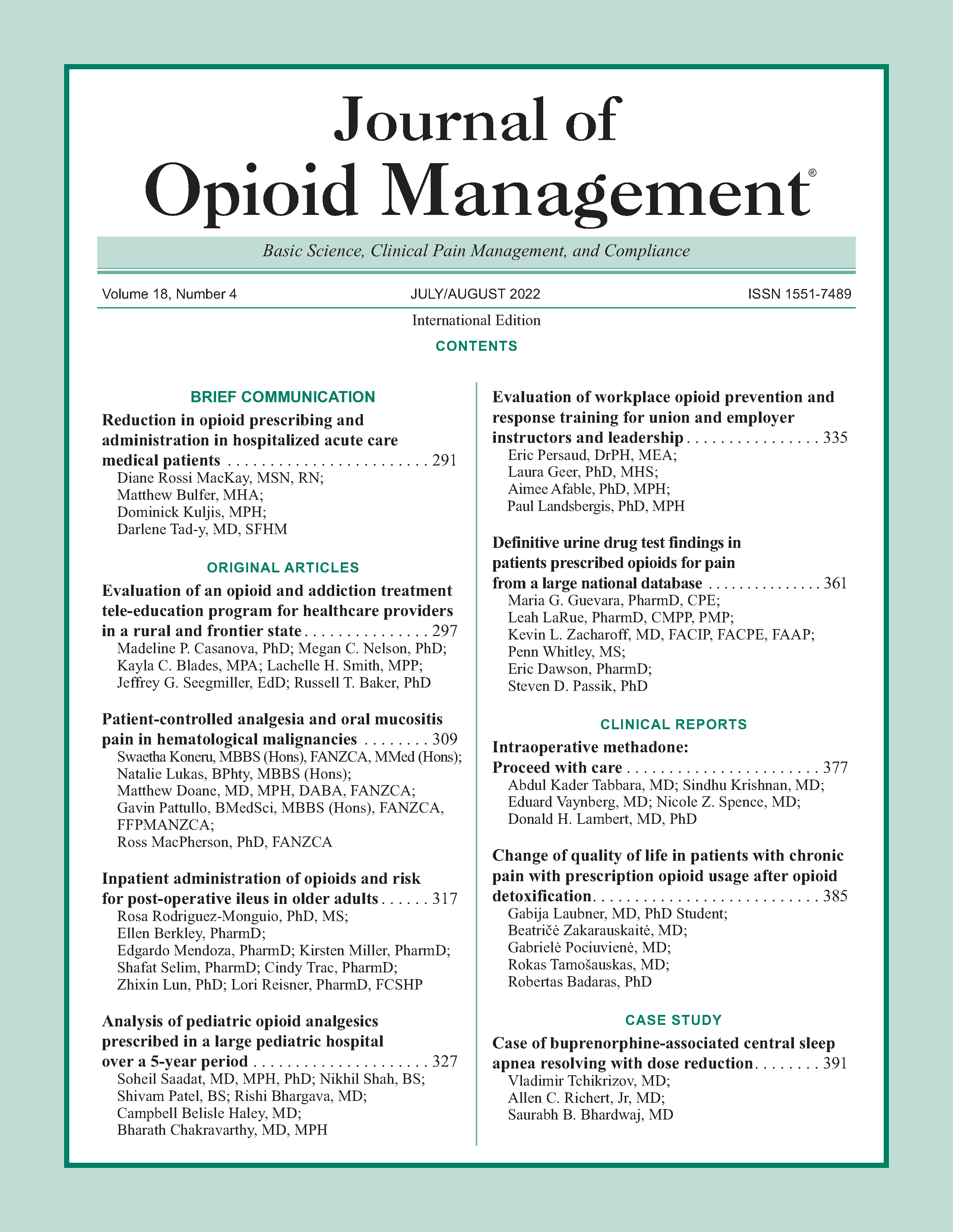Intraoperative methadone: Proceed with care
DOI:
https://doi.org/10.5055/jom.2022.0730Keywords:
perioperative pain, perioperative methadone, respiratory depression, analgesia, polypharmacyAbstract
A recent review suggests minimal respiratory depression (RD) after perioperative methadone, while another identified RD in up to 37 percent of patients. A meta-analysis is equivocal. At our institution, five of 75 opioid naive patients (6.6 percent) given perioperative methadone received naloxone. We report three of these cases in detail. Two others were discovered during an electronic medical record search for opioid naïve patients who received methadone plus naloxone during their anesthesia care. Our five patients indicate that RD owing to methadone can occur with excessive perioperative adjuvant medications and/or in patients who are taking home central nervous system depressants. We define perioperative adjuvant medications as medications given by the anesthesiologist prior to induction and intraoperatively. The risks and benefits of perioperative methadone administration, specifically in patients who received post-operative naloxone, deserve further investigation.
References
Murphy GS, Szokol JW: Intraoperative methadone in surgical patients: A review of clinical investigations. Anesthesiology. 2019; 131(3): 678-692. DOI: 10.1097/ALN.0000000000002755.
Gourlay GK, Wilson PR, Glynn CJ: Methadone produces prolonged postoperative analgesia. Br Med J (Clin Res Ed). 1982; 284(6316): 630-631. DOI: 10.1136/bmj.284.6316.630.
Dunn LK, Yerra S, Fang S, et al.: Safety profile of intraoperative methadone for analgesia after major spine surgery: An observational study of 1,478 patients. J Opioid Manag. 2018; 14(2): 83-87. DOI: 10.5055/jom.2018.0435.
Kharasch ED: Intraoperative methadone: Rediscovery, reappraisal, and reinvigoration? Anesth Analg. 2011; 112(1): 13-16. DOI: 10.1213/ANE.0b013e3181fec9a3.
D’Souza RS, Gurrieri C, Johnson RL, et al.: Intraoperative methadone administration and postoperative pain control: A systematic review and meta-analysis. Pain. 2020; 161(2): 237-243. DOI: 10.1097/j.pain.0000000000001717.
Bova SE, Kruer RM, Nesbite SA, et al.: Perioperative methadone prescribing and association with respiratory depression. J Opioid Manag. 2020; 16(6): 443-449. DOI: 10.5055/jom.2020.0602.
Gourlay GK, Willis RJ, Wilson PR: Postoperative pain control with methadone: Influence of supplementary methadone doses and blood concentration–response relationships. Anesthesiology. 1984; 61(1): 19-26.
Desta Z, El-Boraie A, Gong L, et al.: PharmVar GeneFocus: CYP2B6. Clin Pharmacol Ther. 2021; 110(1): 82-97. DOI: 10.1002/cpt.2166.
Komen H, Brunt LM, Deych E, et al.: Intraoperative methadone in same-day ambulatory surgery: A randomized, double-blinded, dose-finding pilot study. Anesth Analg. 2019; 128(4): 802-810. DOI: 10.1213/ANE.0000000000003464.
Gourlay GK, Wilson PR, Glynn CJ: Pharmacodynamics and pharmacokinetics of methadone during the perioperative period. Anesthesiology. 1982; 57(6): 458-467. DOI: 10.1097/00000542-198212000-00005.
Published
How to Cite
Issue
Section
License
Copyright 2005-2025, Weston Medical Publishing, LLC and Journal of Opioid Management. All Rights Reserved.











